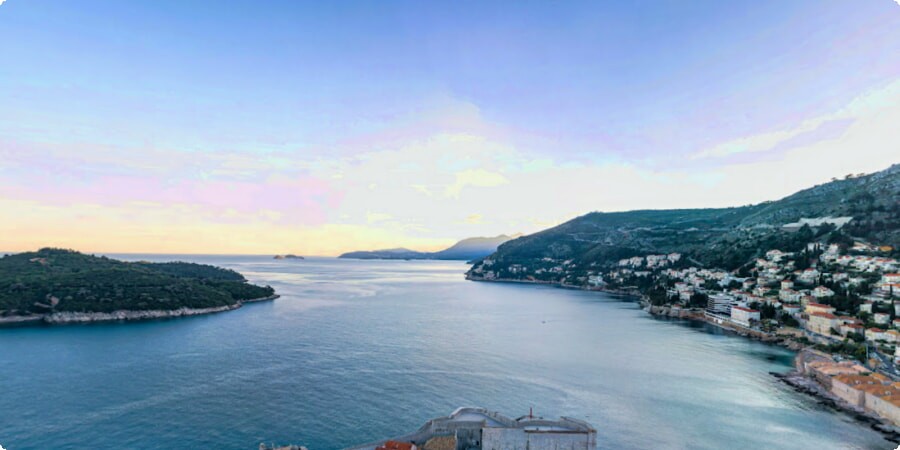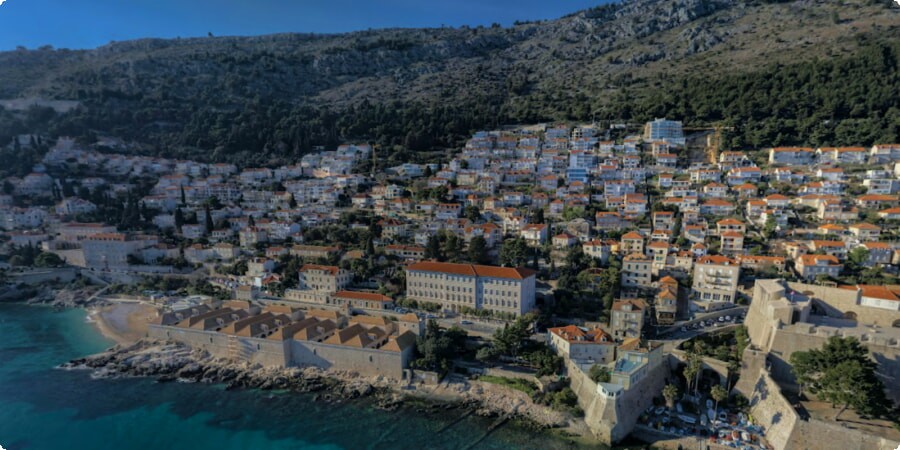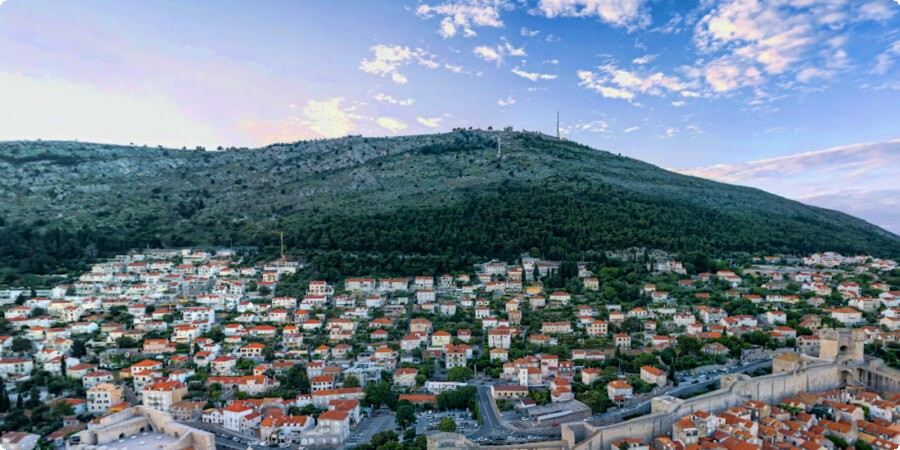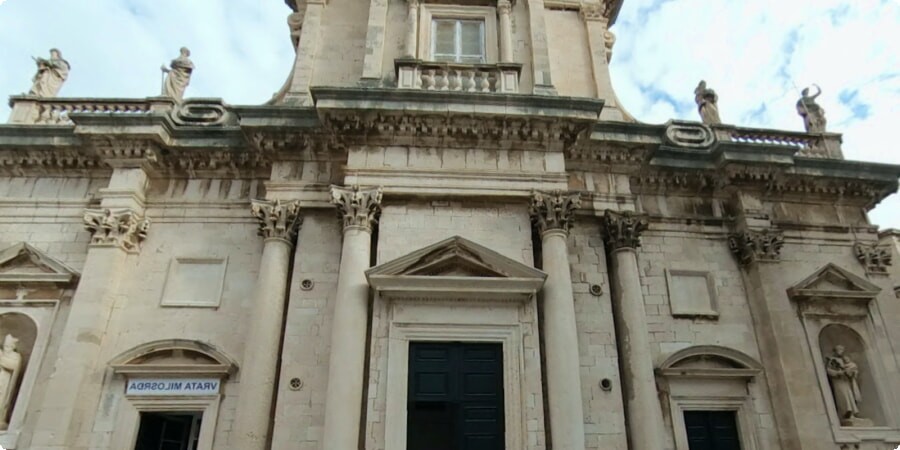Dubrovnik Old Town: A Guide to Croatia's Architectural Marvel
Nestled along the stunning Adriatic coast, Dubrovnik Old Town stands as a jewel of Croatia, enchanting visitors with its blend of historical grandeur and coastal charm. Often referred to as the "Pearl of the Adriatic," this UNESCO World Heritage site boasts a rich tapestry of history, culture, and architectural brilliance. As you stroll through its ancient streets, you'll find yourself transported back in time, surrounded by centuries-old buildings, majestic fortresses, and an atmosphere that echoes the stories of the past.
Historical Background
The history of Dubrovnik Old Town is as captivating as its architecture. Founded in the 7th century, Dubrovnik, originally known as Ragusa, quickly grew into a prominent maritime republic. Its strategic location along the Adriatic Sea made it a vital hub for trade and diplomacy. Throughout its history, Dubrovnik skillfully navigated between powerful empires, including the Byzantine, Venetian, and Ottoman, maintaining its independence and thriving as a center of commerce and culture.
One of the defining moments in Dubrovnik's history was the catastrophic earthquake of 1667, which destroyed much of the city. Despite this disaster, the resilient citizens of Dubrovnik rebuilt their city, preserving its unique architectural heritage. Today, the Old Town stands as a testament to their ingenuity and determination, a place where history is vividly etched into every stone.
Architectural Highlights
Dubrovnik Old Town is a veritable open-air museum, where every corner reveals a new architectural wonder. The city's design reflects a harmonious blend of Gothic, Renaissance, and Baroque styles, each era contributing to its distinctive character. As you explore the town, you'll encounter a stunning array of structures that showcase the artistry and craftsmanship of its builders.
One of the most iconic features of Dubrovnik is its imposing city walls, which encircle the Old Town and stretch for nearly two kilometers. These fortifications, constructed between the 12th and 17th centuries, offer breathtaking views of the Adriatic Sea and the city below. Walking along the walls, you can appreciate the strategic genius that protected Dubrovnik from invaders and natural disasters alike.

Within the city walls, you'll find the magnificent Rector's Palace, a masterpiece of Gothic and Renaissance architecture. This historic building, once the seat of the Rector of the Republic of Ragusa, now serves as a museum, offering a glimpse into the political and cultural life of Dubrovnik's past. Another architectural gem is the Sponza Palace, which combines Gothic and Renaissance elements and has served various functions over the centuries, including as a customs house and mint.
Learn more about Dubrovnik on Wikipedia
Location of Dubrovnik Old Town on Google Maps
For those planning to explore Dubrovnik and its surrounding areas, renting a car can be an excellent option to experience the beauty of the Adriatic coast at your own pace. Book a car in Dubrovnik to ensure a comfortable and convenient journey through this enchanting region.
Landmark Attractions
Dubrovnik Old Town is home to numerous landmark attractions that captivate the imagination and offer a deep dive into the city's rich heritage.
City Walls and Fortresses:
- City Walls: Encircling the Old Town, the city walls are Dubrovnik’s most prominent feature. Stretching nearly two kilometers, these walls offer stunning views of the Adriatic Sea and the terracotta rooftops of the city. Walking along the walls, you can visit several well-preserved fortresses, including the Minceta Tower, Bokar Fortress, and St. John's Fortress, each providing unique vantage points and historical insights.
- Fort Lovrijenac: Known as Dubrovnik's "Gibraltar," Fort Lovrijenac is an imposing structure located just outside the city walls. It was built to protect the city from Venetian attacks and offers spectacular views of the Old Town and the sea.

Rector's Palace:
- This elegant palace, blending Gothic, Renaissance, and Baroque architectural styles, once housed the Rector of the Republic of Ragusa. Today, it serves as a museum showcasing Dubrovnik's political and cultural history, with exhibits that include portraits, coats of arms, and period furniture.
Sponza Palace:
- Sponza Palace is another architectural marvel that has stood the test of time. Built in the early 16th century, it originally served as a customs house and mint. Its elegant colonnades and Gothic-Renaissance style make it a must-visit. The palace now houses the city archives, which include documents dating back to the 12th century.
Hidden Gems and Lesser-Known Sites
Beyond the well-trodden paths lie Dubrovnik’s hidden gems and lesser-known sites, waiting to be discovered by those willing to explore a bit deeper.
St. Ignatius Church and the Jesuit Stairs:
- Tucked away from the bustling main streets, St. Ignatius Church is a Baroque masterpiece with a stunning interior. The church is reached via the impressive Jesuit Stairs, which were modeled after the Spanish Steps in Rome. This picturesque spot offers a peaceful retreat and a chance to admire beautiful frescoes.
War Photo Limited:
- This small but powerful gallery presents gripping photojournalism from various conflicts, including the Croatian War of Independence. The poignant images offer a sobering perspective on the impact of war and are a stark reminder of the region's recent history.
Gundulić Square Market:
- In the heart of the Old Town, Gundulić Square transforms into a bustling market each morning. Here, you can find fresh local produce, handmade crafts, and unique souvenirs. It’s an excellent spot to experience local culture and enjoy the vibrant atmosphere.

Cultural Experiences and Events
Dubrovnik Old Town is not just a historical treasure but also a vibrant cultural hub, offering a plethora of experiences and events that bring the city's rich traditions to life.
Dubrovnik Summer Festival:
- Held annually from mid-July to late August, the Dubrovnik Summer Festival is the city's premier cultural event. It features open-air performances of classical music, theatre, and dance in various historical settings throughout the Old Town. This festival attracts artists and audiences from around the world and is a celebration of art and heritage.
Feast of St. Blaise:
- Celebrated every February 3rd, the Feast of St. Blaise, the patron saint of Dubrovnik, is a deeply rooted tradition. The festivities include a grand procession, religious ceremonies, and various cultural events, reflecting the city's strong religious and cultural identity.
Local Cuisine and Dining Experiences:
- Dubrovnik’s culinary scene is a delightful fusion of Mediterranean flavors and local traditions. From fresh seafood at harbor-side restaurants to traditional dishes like "pasticada" and "zelena menestra," there is something to tantalize every palate. Don’t miss dining in a "konoba," a traditional Croatian tavern, where you can savor authentic local cuisine in a cozy, rustic setting.
For those planning to explore beyond Dubrovnik, renting a car is highly recommended. It allows for a flexible and comfortable journey to discover the wider region, including the stunning Dalmatian coast and charming inland villages. Book a car in Croatia to enhance your travel experience.
Embark on a journey through Dubrovnik Old Town, where history, culture, and architectural splendor converge, offering an unforgettable experience in one of the world's most enchanting cities.

Practical Information for Visitors
Planning a trip to Dubrovnik Old Town involves some practical considerations to ensure a smooth and enjoyable experience.
Getting There:
- By Air: Dubrovnik Airport is the main gateway, located about 20 km from the Old Town. Frequent flights connect Dubrovnik to major European cities. From the airport, you can take a bus, taxi, or rent a car for a convenient journey into the city.
- By Sea: Dubrovnik is a popular stop for Mediterranean cruises, and ferries also connect it to other Croatian cities and nearby islands. The port is just a short distance from the Old Town.
Getting Around:
- The Old Town is best explored on foot due to its pedestrian-only streets. Wear comfortable shoes as the cobblestone paths can be uneven.
- For exploring the surrounding areas, renting a car is advisable. Book a car in Croatia to discover the scenic beauty and historical sites at your own pace.
Accommodation:
- Dubrovnik offers a range of accommodations, from luxury hotels to budget-friendly hostels. For a convenient stay, consider booking a hotel in or near the Old Town to immerse yourself fully in its charm.
- If you're looking for a place with a variety of options, consider staying in Sliema. Book a hotel in Sliema for easy access to the city's attractions and beautiful coastline.
Local Tips and Etiquette
To make the most of your visit to Dubrovnik Old Town, here are some local tips and etiquette to keep in mind:
Respect the Heritage:
- Dubrovnik Old Town is a UNESCO World Heritage site, so it's important to respect its historical significance. Avoid climbing on ancient walls or touching delicate artifacts.
- Be mindful of the locals who live and work in the Old Town. Maintain a respectful noise level, especially in residential areas.
Dress Code:
- While there is no strict dress code for the Old Town, it's advisable to dress modestly when visiting religious sites such as the churches and monasteries.
- Comfortable clothing and shoes are recommended for exploring the narrow, cobblestone streets.
Dining Etiquette:
- Tipping is customary in Dubrovnik, typically around 10% of the bill. It's appreciated but not obligatory.
- When dining in a local konoba (tavern), enjoy the leisurely pace of the meal. Croatian dining culture values conversation and relaxation over a rushed meal.
Preservation Efforts and Future Plans
Dubrovnik Old Town is not only a living museum but also a community that continuously works to preserve its rich heritage and adapt to modern challenges.
Conservation Projects:
- The city actively engages in conservation projects to maintain and restore its historical sites. These efforts are crucial in preserving the Old Town's unique character and ensuring that future generations can enjoy its beauty.
- Collaborative efforts with international organizations help fund and support these projects, highlighting the global significance of Dubrovnik's heritage.
Sustainable Tourism:
- Dubrovnik is committed to promoting sustainable tourism practices. This includes managing the number of visitors to prevent overcrowding, particularly during peak tourist season.
- The city encourages eco-friendly practices, such as reducing plastic use and promoting local products and services.
Community Involvement:
- The local community plays a vital role in preserving the cultural heritage of Dubrovnik. Events, workshops, and educational programs are organized to raise awareness and engage both residents and visitors in the city's rich history and traditions.
Visiting Dubrovnik Old Town is a journey through time, offering a blend of historical wonders, cultural experiences, and breathtaking beauty. Whether you're walking along the ancient city walls, exploring hidden gems, or immersing yourself in local traditions, Dubrovnik promises an unforgettable adventure.